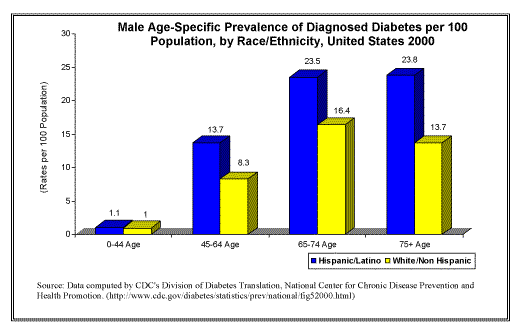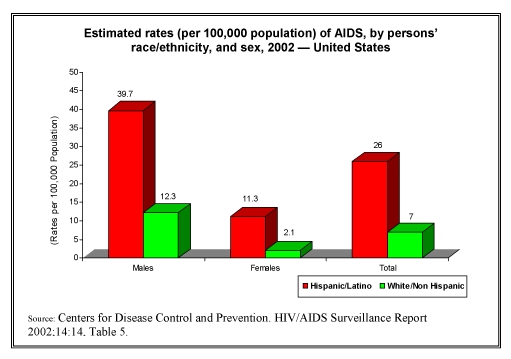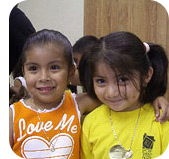Science impacts people living in the United States on a daily basis. One doesn’t have to be an organic chemist to obtain or benefit from the knowledge of science. Every time anyone watches television, drives a car or eats a seedless watermelon, he or she has benefited from the advances in science. The most prominent way that science affects the social well being of people, however; is the scientific advances in the field of medicine. In the United States we have some of the world’s best hospitals and doctors. Yet, millions of people are unable to access the vast amount of medical recourses that this country has to offer. Some ethnic groups in the United States throughout the 20th and into the 21st century have continually been robbed from the basic healthcare that this country possesses. Latinos are the largest growing minority race in the United States and the Census Bureau projects that by the year 2040 there will be 87.5 million Latinos living in the United States 18. Of this growing population, 63% have no access to healthcare services and are at significantly higher risks of HIV, Diabetes, and asthma 19 . The Latino population is at a higher risk for these diseases due to multiple factor such as lack of proper education, living environment, and insufficient income.

Diabetes
Diabetes is a fairly common disease caused by high levels of glucose resulting from defects in insulin production
20. Out of the current population of 30 million approximately 2 million have been diagnosed with diabetes and those numbers are expected to grow drastically. If nothing is done to curb this trend, is projected that 50 percent of the Latino Children born in 2000 will likely become diabetic in their life time. Diabetes can cause many complications including such as cardiovascular disease, blindness, and if left untreated, death The major cause of diabetes is living an unhealthy lifestyle. Eating too much while not exercising can drastically raises the chances of a person developing the disease. So why are hispanics at such a high risk for obtaining the disease? The biggest reason is do to the lack of education and awareness of the nature of Diabetes within the Latino community.
The cure to diabetes includes a self administered regiment of taking insulin injections, eating healthy foods, and exercising. Since the cure of this disease is dependent on the individual's understanding of the treatments and the nature of the disease, the well being of the Latino population is very much dependent on the amount of information that they receive about diabetes. The increasing numbers of Latinos with diabetes is a direct reflection of the lack of programs offered to Latinos to educate them on the nature and prevention of this disease.


AIDS
Since the 1980's HIV has infected many people in the United States. Today Latinos are contracting the HIV virus at an alarming rate. Though Latinos do not account for as many HIV cases as African Americans, they are still being infected at an unusually high amounts. Currently, Latinos account for 14% of the US population, but they account for 20% of the AIDS cases reported 21. Latinos report 3 times as many cases of AIDS as do white non-hispanics, and AIDS was the 6th Leading cause of death for Latinos from ages 25-34 in 2002 22. As with Diabetes, Latinos are not being educated about the characteristics HIV Virus and its consequences. Many Latinos are still engaging in unprotected sex which drastically increases their chances of contracting the disease. Like diabetes there is a lack of the knowledge of the disease in the general population of Latinos. Often times Latinos are unaware of the seriousness of the consequences of contracting the disease. The National Alliance of State and Territorial AIDS Directors (NASTAD) says that “Cultural taboos associated with HIV/AIDS and dwindling resources often prevent Latinos from receiving proper prevention messages, screening, and health care services” 23 .
 
Asthma
Along with an abnormally high percentage of HIV and Diabetes cases among the Latino population, there is also an alarming amount of cases of asthma. When disecting the number of Latinos who have Asthma there is a significant difference between the different nationalities of the Latinos. In a census done in 2002 Puerto Ricans had the largest amount Asthma cases in the United States while Mexicans had one of the lowest rates. This difference is not understood completely, but one of the hypotheses is that Puerto Ricans do not respond as well to common medications used to combat asthma such as albuterol. These differences within the Latino population only increase the need for scientist to try to better understand the differences between the Latino populations. With more research scientist may be able to better explain the increased prevalence of asthma in the Puerto Rican population, which in turn will help doctors to better understand the variance of the needs of specific nationalities within the Latino population.
Lack of Healthcare
In addition to being unaware of most precautionary measures, the majority of Latinos simply cannot afford to pay for the medical help that they need and deserve once they become ill. A UCLA study showed that the Latino population is the most uninsured minority in the United States. The lack of health insurance coupled with the fact that many Latinos live in inadequate housing and below the poverty line combines to put Latinos at serious risk when they become sick. Due to the fact that Latinos are only growing in population, their voice is beginning to be heard and programs are being setup to improve the serious situation of Latinos and the Lack of medical resourses they are able to obtain.
 
The entire healthcare picture of Latinos may initially appear grim, but it does have some signs of improvements. There are many private and public organizations which have formed to improve and educate Latinos how to live healthy life styles. National Diabetes Education Program is instructing Latinos how to better live a healthier and more active life stile in order to reduce the chance that they will obtain diabetes. Also National Latino Aids Awareness Day is currently going out into Latino Communities and making them aware of the risks of unprotected sex and the importance of being tested and having partners tested before engaging in intercourse. Other programs such as The National Hispanic Prenatal Help Line and National Council of La Raza are fighting for the rights of Hispanics to receive adequate health insurance and coverage. Though all of these programs have been developed to help the Latino population with their continuing struggle of obtaining sufficient healthcare coverage and knowledge, their greatest resource may be in their strength of numbers as was displayed in May of 2006 during the Immigration Protest. If Latinos unite and demand that they deserve the benefits of the scientific advances in the field of Medicine, then Washington DC will have no choice but to listen.
|






